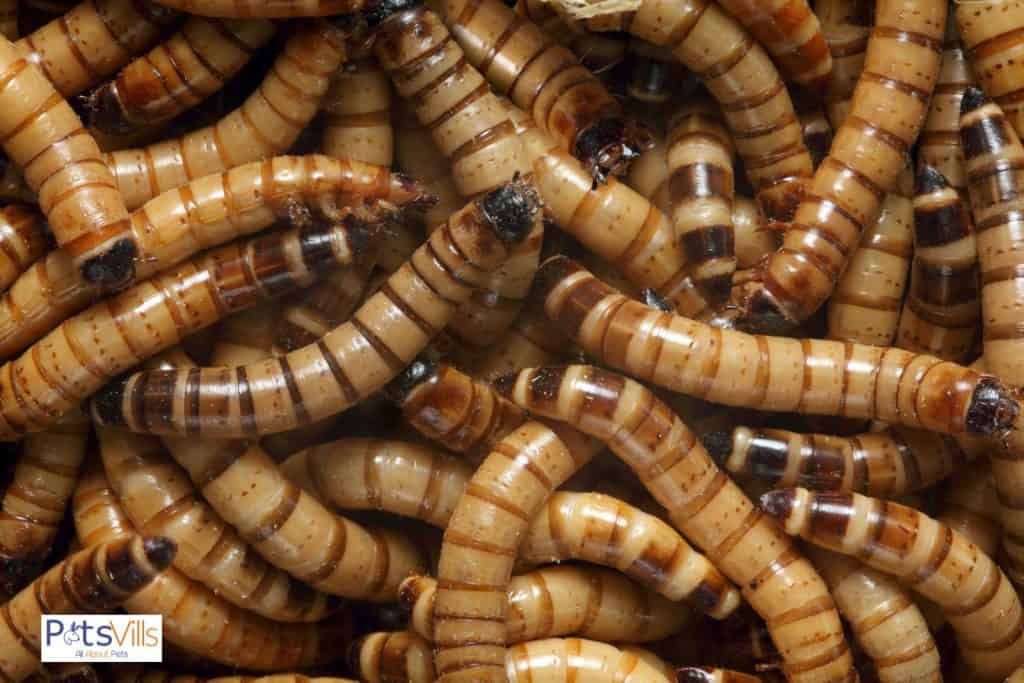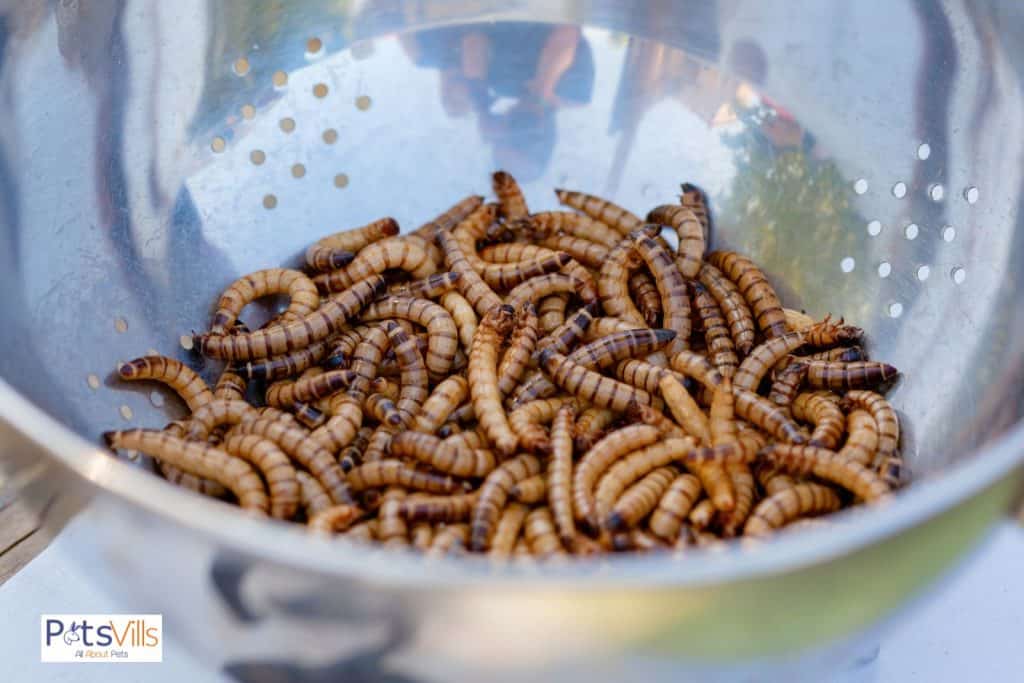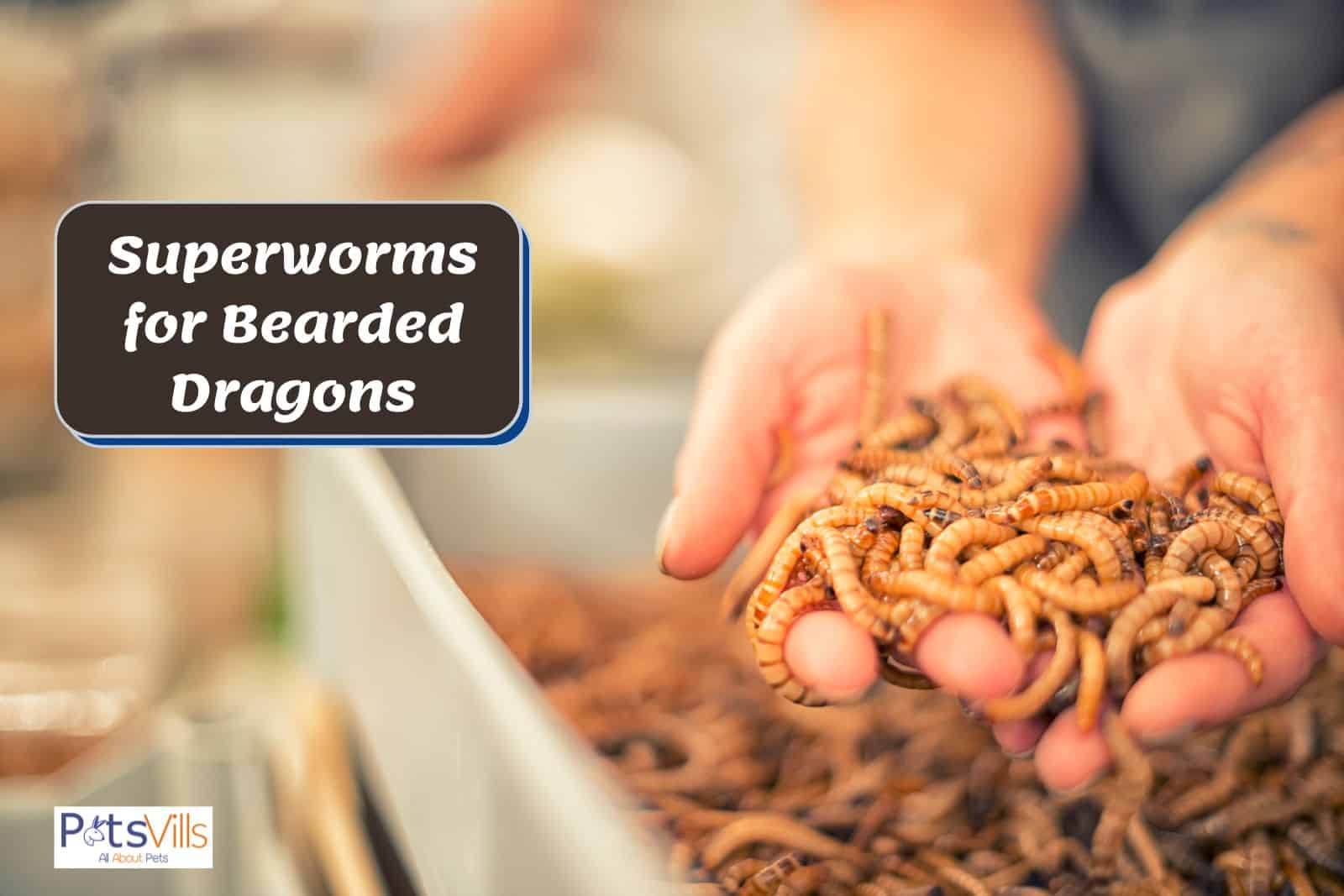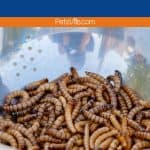Many reptile owners wonder about the value of superworms for bearded dragons.
According to reptile experts, superworms offer tremendous value by being an excellent protein source that can help spice up a beardie’s nutritious diet.
But there’s much more to these worms than their protein percentage.
So please read on, and learn all about them to see whether they’re suitable for your beardie.
Table of Contents
Quick Summary
- Superworms aren’t considered worms. Instead, these critters are darkling beetle larvae of a species called Zophobas morio. They can reach up to two inches with the thickness of a pencil when fully grown.
- Several benefits come from feeding beardies superworms. These insects are a high-level protein source, engage hunting instincts, and offer a satisfying taste.
- Risks are also involved with using superworms. Feeding a beardie too many can lead to gut impaction, obesity, and metallic bone disease.
- Owners can avoid these risks by feeding their dragons superworms once a week. It should only be two or three worms per feeding.
What Are Superworms for Bearded Dragons?
The first thing to know about superworms is that their name is a little deceptive. They aren’t actual worms but are a larva of the darkling beetle Zophobas morio (1).

So why are they called superworms instead of super beetles? It mainly boils down to their appearance, looking much closer to worms than a beetle.
Their appearance can be a little off-putting due to their size. Superworms will measure up to 2 inches when fully grown with a thickness of a pencil.
Honestly, the mental picture alone gives me goosebumps. But this size makes them a sought-out quality food as these insects are 5x larger than mealworms.
Related: What Insects Do Bearded Dragons Eat?
Can Your Bearded Dragon Eat Superworms?
It shouldn’t be a shocking answer, but bearded dragons can eat superworms. These insects are a healthy, special treat full of protein that beardies love to eat.
But owners must realize the benefits and disadvantages of providing superworms. It’s best to be overly informed about everything being put into your beardie’s body.
So I’ll take you through the positives and negatives to offer better insight. You can then decide whether these worms are the right staple insect treat for your beardie.
1. Benefits
- Excellent source of protein: Superworms are known for their high protein percentage, usually around 19%. Beardies need protein as they don’t get much from fruits/vegetables.
- It makes beardies work for their food: Superworms will move all over the cage. So it gives your beardie something to chase, encouraging exercise and engaging their hunting instincts.
- Promotes better skin health: Omega-3 fatty acids are embedded inside the insects, which will help prevent skin issues.
- Beardies love the taste: Wild” bearded dragons are not picky eaters” (2). However, every beardie owner knows how picky captive ones can be when they feel their food isn’t tasty enough. These tasty worms represent an easy way to stop this issue.
- Stable source of vitamins and minerals: Superworms contain vitamins A, B, C, and D, while also offering calcium and magnesium. All of these are beneficial to a beardie’s overall well-being.
- Solid water source: This can be a solid secondary hydration to a water bowl. Pet owners can superworms’ 50% moisture rate to help hydrate their beardies.
2. Disadvantages
- Unclean superworms can contain harmful bacteria and parasites: These issues will lead to health problems and diseases. So it’s vital to clean and disinfect any purchased online or at pet stores before offering them to beardies.
- High-fat content: Superworms have a lot of fat in them. It’s why beardies love, but too many can cause obesity. So a bearded dragon owner should limit the intake to once per week.
- Contains more phosphorus than calcium: This ratio is problematic because too much phosphorus can prevent new calcium. Due to this, it could cause MBD (metallic bone disease) (3). It’s another reason why one superworm feeding per week is a good rule to follow.
- Risk of gut impaction: Superworms feature a hard exoskeleton, which can be problematic for their digestive tract. Pieces of it sit in a beardie’s gut for long periods. Your dragon will pass them in small amounts, but an excessive influx can result in gut impaction.
What’s The Best Way to Use Superworms?
If you want to use superworms, there’s a correct procedure. The following sections will discuss everything from how many to the feeding method.
As a result, you’ll be fully prepared to give your dragon these worms as a tasty treat. Let’s start by looking at the correct number of worms to feed them:
1. How Many Superworms to Give Your Bearded Dragon
As mentioned earlier, these insects are known for their high-fat content. It’s also combined with a hard exoskeleton and high phosphorus level.
What does this combination of attributes conclude? First, it screams that moderation is crucial when feeding your bearded dragon these critters.
A good rule of thumb for adult beardies is two or three worms once a week. Some owners do by twice a week, but once is more than enough for this popular feeder insect.
Owners with juvenile or baby dragons should stick with this feeding schedule. But I wouldn’t feed them to juveniles or baby bearded dragons unless given permission by your vet.
2. How to Store Superworms
Storing these excellent feeder insects properly is essential to maximizing their benefits. Otherwise, they can become corrupted by bacteria and parasites, which isn’t ideal.
Most experts suggest placing them in plastic containers with air holes. I’d try my best to purchase containers with ventilated lids.

These options may cost a bit more, but they do an excellent job of preventing bacteria. It’s a simple way to ensure your feeder insects remain as pristine as possible.
As for the storage climate, these insects don’t need a room with a specific temperature. These live feeder insects will thrive at warm room temperatures. (70 to 80 F)
3. The Correct Feeding Procedure
You’ll want to start this procedure by gut-loading these perfect insects with a calcium supplement. This process must be done a day (24 hours) before the feeding.
In doing so, this action will help counter the high phosphorus levels. You can also use nutritious cricket gut-loading food as an alternative to calcium supplements.
Next, feeding these popular insects to bearded dragons isn’t too tricky. Many wear gloves and utilize tweezers to place them right into their dragon’s feeding bowl.
This technique is my preferred method, especially with my older dragon. He’s not too fond of hunting his source of food at this point.
If your adult bearded dragon loves hunting, try placing the worm somewhere else. However, it should still be near the food bowl, within a couple of inches.
Juvenile bearded dragons should only be fed worms after eating a meal of the best food option possible. It’ll help prevent them from being overly picky eaters as they age.
FAQs
Can bearded dragons eat superworms daily?
Bearded dragons shouldn’t eat superworms daily. It can lead to a horrible cause of gut impaction and other serious health issues.
Which is better, mealworms or superworms?
Superworms are better for reptiles than regular mealworms or giant mealworms. Their larger size and higher nutritional value make them more suitable treats for bearded dragons.
Conclusion
Overall, superworms for bearded dragons are an ideal treat. Your beardie will benefit significantly from their high protein percentage and love the taste.
But moderation remains key when feeding beardies superworms. So keep their inclusion down to a feeding of two or three superworms once per week.

Did you ever try feeding superworms to your beardies? Let us know in the comments section!
Resources
- 1. Validate User [Internet]. academic.oup.com. Available from: https://academic.oup.com/jinsectscience/article/21/2/13/6218202
- 2. Schabacker S. Bearded Dragons [Internet]. National Geographic. 2019. Available from: https://www.nationalgeographic.com/animals/reptiles/facts/bearded-dragon
- 3. Metabolic Bone Disease – an overview | ScienceDirect Topics [Internet]. www.sciencedirect.com. [cited 2022 Nov 24]. Available from: https://www.sciencedirect.com/topics/veterinary-science-and-veterinary-medicine/metabolic-bone-disease#:~:text=SECONDARY%20NUTRITIONAL%20HYPERPARATHYROIDISM-

My name is Ben Roberts, and I absolutely love animals. So, naturally, I love writing about them too! As far as my animals, I have a Pit-bull, a Beagle-lab mix, a Chihuahua, and one old cat. Each one of them provides me with a new adventure every day. And the best part is they’re all best friends. Well, except the cat when he gets a little annoyed.
FIND HIM ON: FACEBOOK and TWITTER.
Read his latest ARTICLES
Learn more about Benhere


